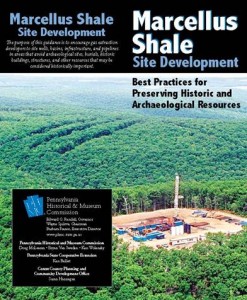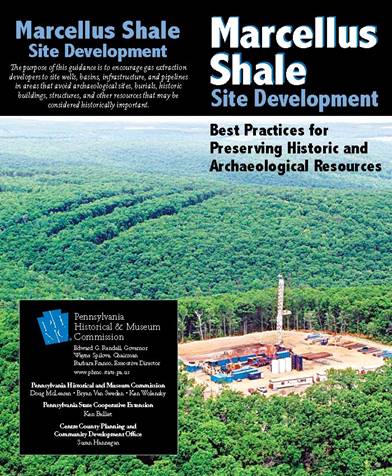In the past five years since Marcellus shale drilling has started, the pace of archaeological survey in the northern tier and the western counties has increased sharply.
In the northern tier, which is part of my review region, this increase is well illustrated by looking at Bradford County. In terms of raw numbers, the PA HPO reviewed 3 archaeological reports in Bradford County in the Federal Fiscal Years (FFY) 2006 through 2008. In FFY 2009 through 2011, after Marcellus shale drilling started in earnest, we reviewed 79 reports in the county. For FFY 2012 and 2013 to date, we have reviewed 135 reports. With all this work being done, you would expect archaeological data to be coming in at a comparable pace. Unfortunately, this is not the case. Of the 135 reports from FFY 2012 and 2013, 14 have reported archaeological sites being found; a rather low success rate for finding archaeological sites. I do not think this is from a lack of archaeological sites present in the region, but rather where archaeological survey is being undertaken and why.
 Marcellus Shale projects are permitted by the Department of Environmental Protection (DEP), the Army Corp of Engineers (Corps), and Commonwealth land holding agencies such as the Game Commission and DCNR. Most of these projects are permitted by the DEP and the Corps on private land. For projects on Commonwealth lands, the PA HPO has the authority to require survey, but on private land the PA HPO acts in an advisory capacity to the permitting agencies. For DEP permitted projects on private land, archaeological survey is the responsibility of the Pennsylvania Historical and Museum Commission under Act 70 of the Pennsylvania History Code. The Commonwealth Archaeology Program was created to do these surveys; however, this program was eliminated as a result of budget cuts in the last decade. As a result, the only archaeological survey being undertaken for Marcellus Shale on private land is within Corps permit areas. These permits are mostly issued for gas gathering lines that run from the gas wells to the interstate transmission pipelines and the permit areas usually extend 100 feet (30 meters) from the edge of wetlands, streams, and rivers. The wells and pads and associated holding ponds are not usually issued Corps permits so they are not surveyed. The result of this bureaucratic maze is that even with the large numbers of surveys being undertaken, the areas being surveyed are not very large and they are not necessarily archaeologically sensitive.
Marcellus Shale projects are permitted by the Department of Environmental Protection (DEP), the Army Corp of Engineers (Corps), and Commonwealth land holding agencies such as the Game Commission and DCNR. Most of these projects are permitted by the DEP and the Corps on private land. For projects on Commonwealth lands, the PA HPO has the authority to require survey, but on private land the PA HPO acts in an advisory capacity to the permitting agencies. For DEP permitted projects on private land, archaeological survey is the responsibility of the Pennsylvania Historical and Museum Commission under Act 70 of the Pennsylvania History Code. The Commonwealth Archaeology Program was created to do these surveys; however, this program was eliminated as a result of budget cuts in the last decade. As a result, the only archaeological survey being undertaken for Marcellus Shale on private land is within Corps permit areas. These permits are mostly issued for gas gathering lines that run from the gas wells to the interstate transmission pipelines and the permit areas usually extend 100 feet (30 meters) from the edge of wetlands, streams, and rivers. The wells and pads and associated holding ponds are not usually issued Corps permits so they are not surveyed. The result of this bureaucratic maze is that even with the large numbers of surveys being undertaken, the areas being surveyed are not very large and they are not necessarily archaeologically sensitive.
 When the PA HPO reviews a project, we look at the entire project area regardless of the overlapping agency jurisdictions. A statement of high probability of the presence of archaeological resources speaks to archaeological sensitivity within that project area. High probability areas in the Northern Tier include floodplains and floodplain terraces, dry areas within 300 feet of wetlands and streams, hill benches, upland flats (in particular those backed by south facing hill slopes), and saddle depressions. Since little work has been previously undertaken in most of the Northern Tier counties, much about prehistoric land use is still unknown in the region. In this way, the Marcellus Shale boom has the potential to add greatly to our knowledge of the archaeology of this region, but only if the projects are surveyed in their entirety. This is to say, if all archaeologically sensitive areas are tested. What is being tested, however, is 100 feet from wetlands, streams, and rivers. Many of the areas being tested are narrow stream valleys with recent sediments and wetland margins which are not necessarily archaeologically sensitive. Terraces and hill benches in proximity to these topographic locations may be archaeologically sensitive, but they are not being tested owing to the regulatory framework. Broad floodplains outside of Corps permit areas, in some cases with known archaeological sites, are not being tested for the same reason. For most projects in the uplands, the effort to survey high probability areas would not be much greater than the effort already being undertaken; however, it would be a much better use of time and effort.
When the PA HPO reviews a project, we look at the entire project area regardless of the overlapping agency jurisdictions. A statement of high probability of the presence of archaeological resources speaks to archaeological sensitivity within that project area. High probability areas in the Northern Tier include floodplains and floodplain terraces, dry areas within 300 feet of wetlands and streams, hill benches, upland flats (in particular those backed by south facing hill slopes), and saddle depressions. Since little work has been previously undertaken in most of the Northern Tier counties, much about prehistoric land use is still unknown in the region. In this way, the Marcellus Shale boom has the potential to add greatly to our knowledge of the archaeology of this region, but only if the projects are surveyed in their entirety. This is to say, if all archaeologically sensitive areas are tested. What is being tested, however, is 100 feet from wetlands, streams, and rivers. Many of the areas being tested are narrow stream valleys with recent sediments and wetland margins which are not necessarily archaeologically sensitive. Terraces and hill benches in proximity to these topographic locations may be archaeologically sensitive, but they are not being tested owing to the regulatory framework. Broad floodplains outside of Corps permit areas, in some cases with known archaeological sites, are not being tested for the same reason. For most projects in the uplands, the effort to survey high probability areas would not be much greater than the effort already being undertaken; however, it would be a much better use of time and effort.
For more information on historic preservation as it relates to Marcellus Shale gas development, please consider our best practices document. In particular, we want to emphasize planning ahead of well and gas line development in order to avoid impacts to cultural resources.

Leave a Reply